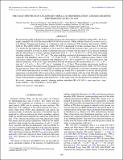THE X-RAY SPECTRUM OF A PLANETARY NEBULA AT HIGH RESOLUTION:
Author(s)
Yu, Young Sam; Nordon, Raanan; Kastner, Joel H.; Houck, John C.; Behar, Ehud; Soker, Noam; ... Show more Show less
DownloadYu-2009-THE X-RAY SPECTRUM O.pdf (1.941Mb)
PUBLISHER_POLICY
Publisher Policy
Article is made available in accordance with the publisher's policy and may be subject to US copyright law. Please refer to the publisher's site for terms of use.
Terms of use
Metadata
Show full item recordAbstract
We present the results of the first X-ray gratings spectroscopy observations of a planetary nebula (PN)—the X-ray-bright, young BD +30°3639. We observed BD +30°3639 for a total of ~300 ks with the Chandra X-ray Observatory's Low Energy Transmission Gratings in combination with its Advanced CCD Imaging Spectrometer (LETG/ACIS-S). The LETG/ACIS-S spectrum of BD +30°3639 is dominated by H-like resonance lines of O VIII and C VI and the He-like triplet line complexes of Ne IX and O VII. Other H-like resonance lines, such as N VII, and lines of highly-ionized Fe are weak or absent. Continuum emission is evident over the range 6-18 Å. Spectral modeling indicates the presence of a range of plasma temperatures from Tx ~ 1.7 × 10[superscript 6] K to 2.9 × 10[superscript 6] K and an intervening absorbing column NH ~ 2.4 × 10[superscript 21] cm[superscript –2]. The same modeling conclusively demonstrates that C and Ne are highly enhanced, with abundance ratios of C/O ~ 15-45 and Ne/O ~ 3.3-5.0 (90% confidence ranges, relative to the solar ratios), while N and Fe are depleted, with abundances N/O ~ 0.0-1.0 and Fe/O ~ 0.1-0.4, respectively. The intrinsic luminosity of the X-ray source determined from the modeling and the measured flux (FX = 4.1 × 10[superscript –13] ergs cm[superscript –2] s[superscript –1]) is LX ~ 8.6 × 10[superscript 32] erg s[superscript –1] (assuming D = 1.2 kpc). These gratings spectroscopy results are generally consistent with earlier results obtained from X-ray CCD imaging spectroscopy of BD +30°3639, but are far more precise. Hence, the Chandra/LETG-S results for BD +30°3639 place severe new constraints on models of PN wind-wind interactions in which X-ray emitting gas within PNs is generated via shocks and the plasma temperature is moderated by effects such as heat conduction or rapid evolution of the fast wind. The tight constraints placed on the (nonsolar) abundances directly implicate the present-day central star—hence, ultimately, the intershell region of the progenitor asymptotic giant branch star—as the origin of the shocked plasma now emitting in X-rays.
Date issued
2009-01Department
MIT Kavli Institute for Astrophysics and Space ResearchJournal
Astrophysical Journal
Publisher
Institute of Physics/American Astronomical Society
Citation
Yu, Young Sam, Raanan Nordon, Joel H. Kastner, John Houck, Ehud Behar, and Noam Soker. “ THE X-RAY SPECTRUM OF A PLANETARY NEBULA AT HIGH RESOLUTION: CHANDRA GRATINGS SPECTROSCOPY OF BD +30°3639 .” The Astrophysical Journal 690, no. 1 (December 1, 2008): 440–452. © 2008 American Astronomical Society.
Version: Final published version
ISSN
0004-637X
1538-4357